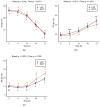Breed-Specific Responses of Rabbit Semen to Chilling Storage: Sperm Quality, Acrosome Status, and Oxidative Stress Biomarkers
- PMID: 40867712
- PMCID: PMC12382761
- DOI: 10.3390/ani15162384
Breed-Specific Responses of Rabbit Semen to Chilling Storage: Sperm Quality, Acrosome Status, and Oxidative Stress Biomarkers
Abstract
Artificial insemination (AI) in rabbits depends largely on chilled semen storage, but the physiological responses to chilling and associated biochemical changes in seminal plasma (SP) remain poorly understood, particularly across breeds. This study aimed to compare the semen preservation capacity of Algerian local population (LAP) and New Zealand White (NZW) rabbits and to explore the relationship between SP oxidative stress biomarkers and sperm traits during 72 h of chilled storage at 5 °C. Semen pools (nine/breed) were evaluated at 0, 4, 24, 48, and 72 h for motility, viability, and acrosome status. Oxidative stress markers were also assessed in the SP, including malondialdehyde (MDA), reactive oxygen metabolites (ROMs), superoxide dismutase (SOD), glutathione peroxidase (GPX), and catalase (CAT). LAP sperm showed higher motility (p < 0.001) and viability (p < 0.05), particularly between 4 h and 48 h, and exhibited a lower rate of acrosome reaction (p < 0.001) from 48 h to 72 h. Lower SOD and higher CAT activity in LAP (p < 0.001), correlated with MDA and acrosome status, respectively, may reflect a more balanced antioxidant response. Lipid peroxidation did not appear to be the main factor driving sperm deterioration (p > 0.05). These results demonstrate that LAP rabbits exhibit better resilience to chilled storage compared to NZW and highlight the potential value of CAT and SOD activities as indicators of sperm resilience during chilled storage. Further studies are required to validate and extend these findings, with the aim of improving semen preservation strategies.
Keywords: acrosome status; antioxidant enzymes; chilled semen storage; oxidative stress; rabbit; seminal plasma; sperm quality.
Conflict of interest statement
The authors declare no conflicts of interest.
Figures




Similar articles
-
Effect of idebenone supplementation in a semen extender on boar spermatozoa quality during liquid storage.Vet World. 2025 Jun;18(6):1479-1486. doi: 10.14202/vetworld.2025.1479-1486. Epub 2025 Jun 10. Vet World. 2025. PMID: 40689187 Free PMC article.
-
Seminal plasma metabolomics and sperm lipidomics profiles of bull semen with different total progressive motile sperm count.J Anim Sci. 2025 Jan 4;103:skaf012. doi: 10.1093/jas/skaf012. J Anim Sci. 2025. PMID: 39887007
-
Protective Effect of Cinnamon (Cinnamomum zeylanicum) Extract on the Sperm Quality During Cool Storage of Ram Semen.Vet Med Sci. 2025 May;11(3):e70370. doi: 10.1002/vms3.70370. Vet Med Sci. 2025. PMID: 40309764 Free PMC article.
-
Antioxidants for male subfertility.Cochrane Database Syst Rev. 2014;(12):CD007411. doi: 10.1002/14651858.CD007411.pub3. Epub 2014 Dec 15. Cochrane Database Syst Rev. 2014. Update in: Cochrane Database Syst Rev. 2019 Mar 14;3:CD007411. doi: 10.1002/14651858.CD007411.pub4. PMID: 25504418 Updated.
-
Intra-cytoplasmic sperm injection versus partial zona dissection, subzonal insemination and conventional techniques for oocyte insemination during in vitro fertilisation.Cochrane Database Syst Rev. 2000;(2):CD001301. doi: 10.1002/14651858.CD001301. Cochrane Database Syst Rev. 2000. Update in: Cochrane Database Syst Rev. 2003;(2):CD001301. doi: 10.1002/14651858.CD001301. PMID: 10796764 Updated.
References
-
- Verma O.P., Kumar R., Kumar A., Chand S. Assisted Reproductive Techniques in Farm Animal—From Artificial Insemination to Nanobiotechnology. Vet. World. 2012;5:301–310. doi: 10.5455/vetworld.2012.301-310. - DOI
-
- Castellini C., Mattioli S., Dal Bosco A., Collodel G. The Rabbit Male Reproduction. In: Simoes J., Monteiro J.M., editors. Veterinary Care of Farm Rabbits: A Complete Practice Guide to Rabbit Medicine and Production. Springer; Cham, Switzerland: 2024. pp. 269–294. - DOI
-
- Di Iorio M., Manchisi A., Rocco M., Chrenek P., Iaffaldano N. Comparison of Different Extenders on the Preservability of Rabbit Semen Stored at 5 °C for 72 Hours. Ital. J. Anim. Sci. 2014;13:710–714. doi: 10.4081/ijas.2014.3444. - DOI
LinkOut - more resources
Full Text Sources
Research Materials
Miscellaneous

